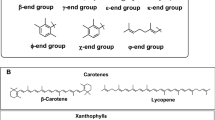Abstract
In this study, we demonstrate the selective in vivo detection of diadinoxanthin (DD) and diatoxanthin (DT) in intact Cyclotella cells using resonance Raman spectroscopy. In these cells, we were able to assess both the content of DD and DT carotenoids relative to chlorophyll and their conformation. In addition, the sensitivity and selectivity of the technique allow us to discriminate between different pools of DD on a structural basis, and to follow their fate as a function of the illumination conditions. We report that the additional DD observed when cells are grown in high-light conditions adopts a more twisted conformation than the lower levels of DD present when the cells are grown in low-light (LL) conditions. Thus, we conclude that this pool of DD is more tightly bound to a protein-binding site, which must differ from the one occupied by the DD present in LL conditions.




Similar content being viewed by others
References
Beer A, Gundermann K, Beckmann J, Buchel C (2006) Subunit composition and pigmentation of fucoxanthin-chlorophyll proteins in diatoms: evidence for a subunit involved in diadinoxanthin and diatoxanthin binding. Biochemistry 45:13046–13053
Buchel C (2003) Fucoxanthin-chlorophyll proteins in diatoms: 18 and 19 kDa subunits assemble into different oligomeric states. Biochemistry 42:13027–13034
Frank H, Young A, Britton G, Cogdell RJ (eds) (1999) The photochemistry of carotenoids. Kluwer, Dordrecht
Goss R, Jakob T (2010) Regulation and function of xanthophyll cycle-dependent photoprotection in algae. Photosynth Res 106:103–122
Goss R, Lohr M, Latowski D, Grzyb J, Vieler A, Wilhelm C, Strzalka K (2005) Role of hexagonal structure-forming lipids in diadinoxanthin and violaxanthin solubilization and de-epoxidation. Biochemistry 44:4028–4036
Goss R, Ann Pinto E, Wilhelm C, Richter M (2006) The importance of a highly active and DeltapH-regulated diatoxanthin epoxidase for the regulation of the PS II antenna function in diadinoxanthin cycle containing algae. J Plant Physiol 163:1008–1021
Goss R, Latowski D, Grzyb J, Vieler A, Lohr M, Wilhelm C, Strzalka K (2007) Lipid dependence of diadinoxanthin solubilization and de-epoxidation in artificial membrane systems resembling the lipid composition of the natural thylakoid membrane. Biochim Biophys Acta 1768:67–75
Grouneva I, Jakob T, Wilhelm C, Goss R (2008) A new multicomponent NPQ mechanism in the diatom Cyclotella meneghiniana. Plant Cell Physiol 49:1217–1225
Grouneva I, Jakob T, Wilhelm C, Goss R (2009) The regulation of xanthophyll cycle activity and of non-photochemical fluorescence quenching by two alternative electron flows in the diatoms Phaeodactylum tricornutum and Cyclotella meneghiniana. Biochim Biophys Acta 1787:929–938
Guglielmi G, Lavaud J, Rousseau B, Etienne AL, Houmard J, Ruban AV (2005) The light-harvesting antenna of the diatom Phaeodactylum tricornutum. Evidence for a diadinoxanthin-binding subcomplex. FEBS J 272:4339–4348
Gundermann K, Buchel C (2008) The fluorescence yield of the trimeric fucoxanthin-chlorophyll-protein FCPa in the diatom Cyclotella meneghiniana is dependent on the amount of bound diatoxanthin. Photosynth Res 95:229–235
Ilioaia C, Johnson MP, Duffy CD, Pascal AA, van Grondelle R, Robert B, Ruban AV (2011) Origin of absorption changes associated with photoprotective energy dissipation in the absence of zeaxanthin. J Biol Chem 286:91–98
Lavaud J, Rousseau B, van Gorkom HJ, Etienne AL (2002) Influence of the diadinoxanthin pool size on photoprotection in the marine planktonic diatom Phaeodactylum tricornutum. Plant Physiol 129:1398–1406
Lavaud J, Rousseau B, Etienne AL (2003) Enrichment of the light-harvesting complex in diadinoxanthin and implications for the nonphotochemical fluorescence quenching in diatoms. Biochemistry 42:5802–5808
Lepetit B, Volke D, Szabo M, Hoffmann R, Garab G, Wilhelm C, Goss R (2007) Spectroscopic and molecular characterization of the oligomeric antenna of the diatom Phaeodactylum tricornutum. Biochemistry 46:9813–9822
Lepetit B, Volke D, Gilbert M, Wilhelm C, Goss R (2010) Evidence for the existence of one antenna-associated, lipid-dissolved and two protein-bound pools of diadinoxanthin cycle pigments in diatoms. Plant Physiol 154:1905–1920
Lutz M, Szponarski W, Berger G, Robert B, Neumann J-M (1987) The stereoisomerism of bacterial, reaction-center-bound carotenoids revisited: an electronic absorption, resonance Raman and [1]H NMR study. Elsevier, Amsterdam
Papagiannakis E, van Stokkum I HM, Fey H, Buchel C, van Grondelle R (2005) Spectroscopic characterization of the excitation energy transfer in the fucoxanthin-chlorophyll protein of diatoms. Photosynth Res 86:241–250
Premvardhan L, Bordes L, Beer A, Buchel C, Robert B (2009) Carotenoid structures and environments in trimeric and oligomeric fucoxanthin-chlorophyll a/c2 proteins from resonance Raman spectroscopy. J Phys Chem B 113:12565–12574
Premvardhan L, Robert B, Beer A, Buchel C (2010) Pigment organization in fucoxanthin chlorophyll a/c(2) proteins (FCP) based on resonance Raman spectroscopy and sequence analysis. Biochim Biophys Acta 1797:1647–1656
Provasoli L, McLaughlin JJ, Droop MR (1957) The development of artificial media for marine algae. Arch Mikrobiol 25:392–428
Robert B (2009) Resonance Raman spectroscopy. Photosynth Res 101:147–155
Ruban AV, Pascal AA, Robert B, Horton P (2001a) Configuration and dynamics of xanthophylls in light-harvesting antennae of higher plants. Spectroscopic analysis of isolated light-harvesting complex of photosystem II and thylakoid membranes. J Biol Chem 276:24862–24870
Ruban AV, Pascal AA, Robert B, Horton P (2001b) Configuration and dynamics of xanthophylls in light-harvesting antennae of higher plants—spectroscopic analysis of isolated light-harvesting complex of photosystem II and thylakoid membranes. J Biol Chem 276:24862–24870
Ruban A, Lavaud J, Rousseau B, Guglielmi G, Horton P, Etienne AL (2004) The super-excess energy dissipation in diatom algae: comparative analysis with higher plants. Photosynth Res 82:165–175
Stransky H, Hager A (1970) The carotenoid pattern and the occurrence of the light-induced xanthophyll cycle in various classes of algae. VI. Chemosystematic study. Arch Mikrobiol 73:315–323
Acknowledgments
This study is funded by FOM-program The Thylakoid Membrane: A Dynamic Switch (FP126; 12.0344) and the Fondation de l’Ecole Normale Superieure (MTAA and RvG) and the Advanced Investigator Grant (267333, PHOTPROT) from the European Research Council (ERC) (R.v.G. & BR). CB gratefully acknowledges the support from the Deutsche Forschungsgemeinschaft (DFG grants Bu 812-4/5).
Author information
Authors and Affiliations
Corresponding author
Rights and permissions
About this article
Cite this article
Alexandre, M.T.A., Gundermann, K., Pascal, A.A. et al. Probing the carotenoid content of intact Cyclotella cells by resonance Raman spectroscopy. Photosynth Res 119, 273–281 (2014). https://doi.org/10.1007/s11120-013-9942-y
Received:
Accepted:
Published:
Issue Date:
DOI: https://doi.org/10.1007/s11120-013-9942-y




